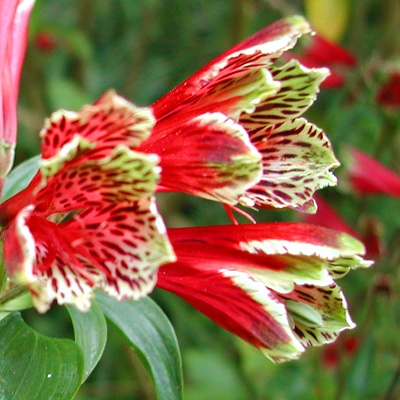Parrot Lily Alstroemeria psittacina
Germinating the seeds » These seeds sprout best if placed in the refrigerator for 4 weeks, after an initial 3 weeks at room temperature. This is to trick the seeds into thinking winter has passed. The tips below explain the process. Plant your seeds when you receive them for best germination. First, soak the seeds in a cup of water for 24 hours. Use small pots or cups that have drainage
holes. Fill with a well-draining soil mix. I use a mix of 1 part
coir fiber Plant 1-2 seeds in each pot, about 1/4 inch (6 mm) deep. Add water until the soil is evenly moist (but not saturated). For the next 3 weeks, ensure that the soil stays moist. Keep the pots between about 68 and 84 degrees F (20-29°C). After 3 weeks, enclose the pots in an airtight plastic container or bag and place in the refrigerator. Ensure that the temperature stays above 35°F (2°C). After 4 weeks (mark your calendar) remove the pots from their container/bag, and keep them in an area that stays between about 65 and 85°F (18-29°C). If you enclose the pots in a plastic dome, leave it open a bit to allow fresh air to circulate, to prevent stem rot later. Germination can occur over a long period, beginning any time after 4 weeks and continuing for up to 6 months. Occasionally, some may take over 6 months, but most should sprout within 1 to 4 months. Once they sprout, give them bright light, with protection from strong afternoon sun. Keep the soil evenly moist (but not constantly saturated). Fertilizing -- The first 6-8 weeks, feed
every 7 days with a very dilute (1/8 strength) liquid fertilizer. Hydroponic fertilizer is ideal for this, because it is easily absorbed and contains all essential nutrients. I use General Hydroponics Flora fertilizer You may transplant them to larger containers when the plants are 3 months old. Repot gently to avoid breaking apart the soil. Water before transplanting, to keep the soil together. It generally isn't bothered by insects, but watch for any pests that can affect your other plants. Tips on growing adult plants are here. Have fun growing them! - Jeff Strange Wonderful Things
|
|||||||||


